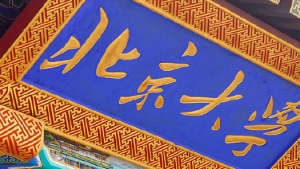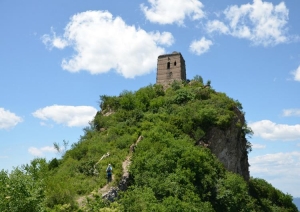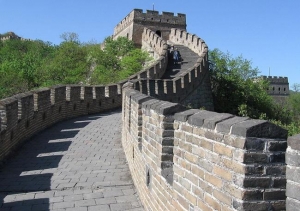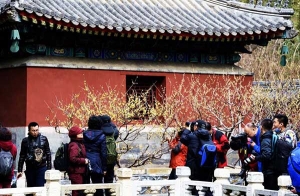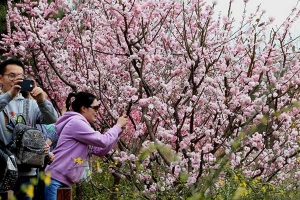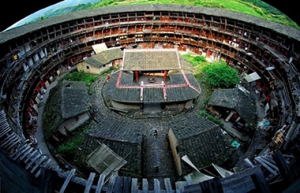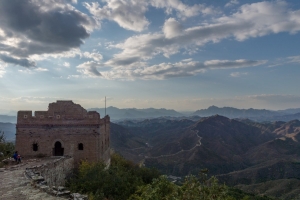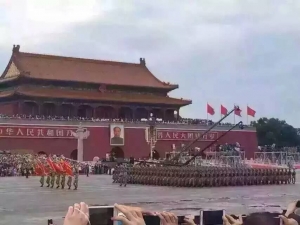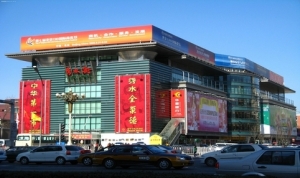News
Peking University is a comprehensive and national key university. The campus, known as "Yan Yuan"(the garden of Yan), is situated at Haidian District in the western suburb of Beijing, with a total area of 2,743,532 square metres (or 274 hectares). It stands near to the Yuanmingyuan Garden and the Summer Palace.
Peking University is proud of its outstanding faculty, including 53 members of the Chinese Academy of Sciences (CAS), 7 members of the Chinese Academy of Engineering (CAE), and 14 members of the Third World Academy of Sciences (TWAS).
The university has effectively combined research on important scientific subjects with the training of personnel with a high level of specialized knowledge and professional skill as demanded by the country's socialist modernization. It strives not only for improvements in teaching and research work, but also for the promotion of interaction and mutual promotion among various disciplines.
Thus Peking University has become a center for teaching and research and a university of a new type, embracing diverse branches of learning such as basic and applied sciences, social sciences and the humanities, and sciences of medicine, management, and education. Its aim is to rank among the world's best universities in the future
Founded in 1898, Peking University was originally known as the Imperial University of Peking. It was the first national university covering comprehensive disciplines in China, and has been a leading institution of higher education in China since its establishment. It also served as the highest administration for education at the beginning of its founding.
In 1912, the university adopted its present name. At the end of the 20th century, the Chinese government put Peking University at the top of its agenda for promoting higher education, with the aim to build a world-class university in the 21st Century. After merging with Beijing Medical University in 2000, Peking University once again was strengthened in its disciplinary structure.
Peking University has continually played the essential role of pioneers in the course of China's modernization. The university's traditional emphasis on patriotism, progress, democracy, and science, together with its educational standards of diligence, precision, factualism, and innovation, have been passed down from generation to generation.
The great-wall is a must for every traveler heading to beijing, it is truly both awe-inspiring and culturally enriching experience, and if you have already been to the world-renowned badaling great wall and are searching for somewhere more untamed and commercialised why not try the sections of the Great Wall at Simatai?
Getting to Simatai
Simatai, located 120 km north of Beijing in the county of Miyun, is renowned for its steepness and amazing state of preservation. If you're traveling there on your own, then careful planning is required. Firstly, you will need to go to Dongzhimen which is a major subway station, after getting off at Dongzhimen you will need to find the long-distance bus station and buy your ticket at the ticket office. The No.980 express buses which go to Miyun are reasonably frequent and cost around 50 Yuan, and the journey from Beijing to Miyun takes around 90 minutes – perfect time to have a nap! Upon arriving in Miyun, you have two choices to get to the Wall: try and strike a deal with a local to get driven there in a private car (Note: that usually costs about 200 Yuan); and the other way is to wait mini-buses that head to the wall (Note: generally, these mini buses take much more time, for they are sporadic and not very speedy). It takes less than an hour from Miyun to the wall, so in total from Beijing to the Wall itself it's a one-way trip of around three-hours, so make sure you head off early in the morning!
Experiencing the Wall
Upon arriving at the wall, especially in summer you will instantly be hit with how hot and sunny it is; so heaps of sunscreen, a hat and sunglasses are all essential. Tickets to get in cost 30 Yuan (US$5). Upon entering you have the options of hiking up the sheer sides of the wall or catching a cable-car to the summit, the cable-car costs 50 Yuan (US$9). Upon reaching the end of the cable-car, there is just a short walk up to the wall proper. Upon my first time visiting the wall I was just amazed with how untouched and well preserved it still remains, a sense that soldiers of the Ming Dynasty could at any moment march once again on its rugged parapets. There are almost no hawkers there, just some windswept old women selling postcards, ice-creams and cold bottles of water. The wall is yours to explore at your own pace. As you walk along the 5.4 kilometer stretch that straddles Beijing City and Hebei Province, you realize just how difficult it must have been to construct, the wall itself sits on a mountain ridge elevated 960metres above sea-level it really is an architectural wonder. According to the locals, during construction of the wall during the Ming Dynasty in order to overcome the problem of ferrying bricks up the rugged, steep ridge-line the laborers would tie individual bricks to goats who would then deliver the bricks up to the wall.
This section of the wall offers spectacular vistas as you peer down on the villages and rice fields that dot the landscape far below , there are also over 15 beacon towers still standing in perfect condition that provide relief from the blaring sun and a chance for photos; a word of caution though the wall becomes steep and difficult to navigate in parts and requires at least two hours to finish, upon arriving at the accessible section of the wall there is a 100 meter flying-fox for those who wish to make a swift and thrilling descent. Despite is comparative remoteness; the untamed beauty and isolation of Simatai make it an attractive alternative to Badaling and a great way to spend a day in Beijing.
Uber driers will never take you to great wall simatai becuase is really really far and its almost another city ,but beijingdrivers will do ,beijingdrivers ,take you to simatai great wall only cost 1000rmb ,including gas and toll and parking ,brand new 5 seats car ,fit for 3 passagesrs .
One of the best preserved section of the Great Wall
Mutianyu (慕田峪) Great Wall, is one of the most famous and best preserved sections of the Great Wall together with Badaling (八达岭) and Jinshanling (金山岭) sections. Located in the northeast of Beijing Municipality, Mutianyu is connected with the smaller hotspot sections of Jiankou in the west and Lianhuachi in the east. This section used to serve as the northern wall defending the capital city and the Imperial power, like a giant galloping dragon on mountain peak preserving the entrance to emperors' kingdom. Important section of the Great Wall, Mutianyu is filled with a great amount of historical and cultural relics as well as the most important number of watchtowers. About 20 of them are distributed along the opened tourism area that stretches for about 2250 meters long. Travelers visiting the Mutianyu Great Wall have the possibility to experience the Great Wall in different ways, whether using the thousands stone steps or a cable car. Definitely one of the best places to hike for experiencing the Great Wall, Mutianyu and its surrounding lush forest and woodland transports everyone back to ancient times, back in Imperial China
History of the Mutianyu Great Wall
Oldest section of the whole Great Wall masterpiece, Mutianyu was first built in the mid-6thcentury, during the Northern Qi Dynasty (550-557). The foundation construction of the defensive wall started during the Qi, while the present wall supervision to strengthen its defensive potential was operated by Generals Xu Da, Tan Lun and Qi Jiguang, during the Ming Dynasty (1368-1644) and Emperor Yongle's reign (1402-1424). Mutianyu was built on a strategic pass and served quickly as the northern protective screen guarding the capital. The walls of the section were built using the materials coming from the nearby Qian'an County. Working everyday for the accomplishment of the Emperor's wish of a material barrier with the outside world, the construction of the Mutianyu Great Wall Gateway was finished to build up in Emperor Longqing's reign (1567-1572). Due to wartimes and the effects of Nature, the wall had to be reconstructed several times such as in 1568 and 1569. Playing its role as a wartime barrier with invaders, the Mutianyu section was a pivotal point on the Great Wall as aliens forces attacked on every sides of the wall. This was only in 1987 that the section was appraised as one of the 16 best scenic spots of Beijing city. Recognized as the World Best of Beijing Tourism in 1992, the Mutianyu Great Wall was then ranked as a 4A grade scenic area in 2002. Mutianyu is since then definitely the largest construction scale of best quality among all sections of the Great Wall.
Mutianyu Great Wall in depth
Despite its old character among all the different sections of the Great Wall, Mutianyu is also renowned for its beauty and importance together with the Juyongguan and the Huilingkou gateways. The Mutianyu section's function, like the whole Great Wall, was to keep enemies under control in the exterior and protect the capital in the interior. Mainly built with granite produced at a few kilometers away, the walls of Mutianyu Great Wall are 7-8 meters high with a top of 4-5 meters wide, and even an abrupt climbing rising up to 117 meters high. The Mutianyu section attracts the attention of its visitors because of its unique characteristics that can be distinguished out of the many sections composing the Great Wall. Indeed, winding through 1.4 miles to the east through mountains and high ridges, the wall looks almost indestructible. Mutianyu is the only section that comprises a total of 22 watchtowers, a number barely seen anywhere else on the Great Wall. Located in a land where flourishes a luxuriant flora, Mutianyu's smaller sections are called according to the surrounding hills. Names such as the "Ox Horn Edge" or the "Flying Eagle Flies Facing Upward" and the "Arrow Lock" are examples of names used by the locals living around the masterpiece. The construction is even more important for its strategic position on the line with the enemy. Indeed, battlements used to take place on both sides of the walls. All these prominent particularities give to Mutianyu its uniqueness and prominence among all sections of the mighty Great Wall.
Watchtowers and other wall elements
Different from other sections composing the Great Wall, Mutianyu section is definitely the area where admiring the most important number of watchtowers and other ancient constructions. When visiting Mutianyu, travelers are left speechless in front of the closely packed enemy towers and perilous passes, densely placed. A total of 22 watchtowers battlements, a shelter for defense soldiers when fighting, are indeed located on the section, with three main one referred as the three hollow enemy towers: one big in the centre and two smaller on both sides. Located on the same level, the three watchtowers are connected to each other inside the wall and compose a rarely seen structure. The outer and inner parapets of the wall are both used to defend against enemies coming from the two sides, a feature very rare on other parts of the Great Wall. In order to reinforce this defensive use, some of the parapets are even seen tooth shaped instead of the regular rectangular form that we see in the Great Wall. Enemy towers, enemy platforms, wall platforms, extension rooms…everything is packed in the same place: an architecture indicating the important strategic position of Mutianyu Great Wall in history and during wartimes.
Surrounding villages and activities
Constructed on a land where villages were already set, cultural and historical relics can be found near to Mutianyu Great Wall. The Mutianyu village was to this point one of the earliest villages near to the Great Wall to be hailed by the Chinese government as a model village because of its rebirth, thanks to tourism and glassware industries. The place is today a favorite of travelers looking for some ancient architecture and typical Chinese insights. Some attractions along the section can be found such as a wheeled toboggan where to ride down on a winding metal track, a great entertainment for kids or parents! Though covered by 96% of forest and grassland, Mutianyu is an area where some branch cities developed on the hill ridge against the inner and outer side of the wall. Flourishing section of the Great Wall, Mutianyu is definitely where coming to have the deepest insight of China's Great Wall and China's gorgeous history.
What to see in the Mutianyu Great Wall today?
When visiting China and planning to have a hike on the Great Wall, Mutianyu must be one of the choices to experience one of the best discovery of this human masterpiece classified to UNESCO. High scenic spot of China, Mutianyu Great Wall is where experiencing many different insights of China starting with a hike and a climbing using a cable-car providing an all-around service. Secured and meeting international standards (No. 1 Cable Car for Great Wall), taking the machine to reach the top of the wall's section is way more rapid and convenient than the huge stairs, used today by the most courageous visitors. If still choosing to climb up step by step, there are two ways available: south and north where appreciating the different sceneries along the Great Wall, changing with the seasons. Not high in altitude but giving some stereoscopic views, Mutianyu is the perfect place to enjoy China's amazing landscapes. Being an amazed and entertained area where to take some rest for a whole day or more, Mutianyu is also where going for spending a good day with friends or family. There, the China Dream Stones City, Lu Ming Recreation Zoo and the Slide Way, are the three newly established scenic areas encompassing the Great Wall culture, stone culture and entertainment at the disposal of visitors.
Gorgeous nature and landscapes along the 4 seasons
Particularity of Mutianyu Great Wall, the surrounding landscape is what makes the difference with other sections of the monument. Indeed, Mutianyu is known for being surrounded with mountains, trees (more than 20 pines species of over 300 years old and about 200 pines species of over 100 year old) and beautiful sceneries. One typical aspect of the section is its changing beauty according to the seasons. Whether visited in spring, summer, autumn or winter, Mutianyu is giving to its visitors the most impressive shots ever seen. Spring and its fragrant flowers vying with each other in beauty and blooming are one of the most famous sightseeing to experience. Summer, recovering mountains with green coats and a delicate sound of flowing lake is enchanting travelers in holiday. Autumn, and its fruitful trees and red leaves dancing with the wind are one of the most praised sceneries by Chinese people. Finally, when winter comes, Mutianyu Great Wall is painted of pure white and coated with silver costume: a northland scene in China, like a dream lived in another world.
Mutianyu travel tips
When visiting Mutianyu Great Wall during your tour in China or stay in Beijing, we can recommend you some travel tips about accommodations and restaurants that are worth a visit.
Around Mutianyu, some farmhouses with preserved authentic architecture and lifestyle can be discovered by the most adventurous. The Fugui Hong Farmhouse (富贵宏农家院, Fugui hong nongjia yuan), Baosheng renjia Farmhouse (宝生人家农家院, Baosheng renjia nongjia yuan) are worth a stay before, in the middle or after your visit of the Great Wall. Place appraised since 2000 as the second grade of hotel in the area, the mountain lodge Great Wall Villa (长城山庄, Changcheng shanzhuang) is sitting at the foot of the Great Wall. Ancient style architecture and elegant court, the villa is perfect for enjoying the fresh air and scenery of the Great Wall. Finally, the Master Fish Restaurant (鱼师傅餐厅, Yu shifu canting) will know how to fill your appetite after a half day hike on this section of the Great Wall.
travel with beijingdrivers ,mutianyu great wall only cost you 600rmb,gm cruze ,brand new car ,with English speaking driver.the very special offer for your may day holiday.
One of the new notions Premier Li Keqiang put forward in this year's Government Work Report on March 5 is a "New era of mass tourism".
In it, the phrase "Paid vacations" appears again as a fundamental aspect of the trend. "We will ensure people are able to take their paid vacations, strengthen the development of tourist and transport facilities, scenic spots and tourist sites, and recreational vehicle parks, and see that the tourist market operates in line with regulations. With these efforts, we will usher in a new era of mass tourism," he said.
Premier Li's mention of "Paid vacations" has ignited widespread public reactions. Liang Jianzhang, co-founder of Ctrip (a leading online travel agency), who views tourism as the most promising industry in the future, believes that the implementation of "Paid vacations" is an incentive to Chinese economy. He maintains that "the average number of travels made by Chinese tourists is still far below that of the developed countries, so in the decades to come, China's tourism industry will have to make great strides and will eventually become a significant driver for economic growth. During this process, opportunities for innovation and employment will increase".
In Liang's opinion, facilitating paid vacations can bring a new cycle of tourism consumption and investment-as long as competent travel products can be developed, stable profit can be expected in the long run.
As far as public holiday arrangement is concerned, several proposals emerged into the spotlight during the ongoing two sessions, all of which focus on a modification of the current holiday arrangement
NPC deputy, deputy director of Shaanxi Provincial Tourism Bureau CSU Mingzheng proposes that the Spring Festival holiday should be extended to 10-12 days from the current 7-day vacation.
Xu said his suggestion is based on the fact that the 7-day holiday is so short that people spend more time on the road more than the time they spend with their families, and many social problems also arise from the crowded scenic spots and traffic jams, while an extension of the Spring Festival holiday, which now is one of the two longest vacations periods in China (the other major vacation is October’s National Day holiday) and makes up a big part of the outbound tourism market, can “better satisfy people’s needs to have more time for family reunion, and at the same time boost consumption, stimulate internal demands and facilitate an upgrade of economic development, plus ease traffic pressure brought on by intensive travel demands in such a short holiday period”,said Xu.
An even bolder proposal comes from Huang Xihua, NPC deputy and director of Huizhou Tourism Bureau in Guangdong province.
She proposes that each month should have a 'golden week', specifically, she wants people to only take one weekend day off in the first three weeks of a month, and reschedule the remaining three days to the end of the month and together with the fourth weekend, people can have a five-day holiday. Huang maintains that this mode needs a pilot run in some places, and this initiative is a good reform direction for both scenic spots and those holidaygoers.
Voices come from all directions and because of the various requirements and conditions in different regions and industries, implementation is an even tougher task than policy-making. However, what can’t be denied is the substantial potential China has for tourism and Chinese people’s ever-increasing need to upgrade their consumption style. According to reports of the National Tourism Administration, In 2015, 120 million Chinese went overseas and spent $104.5 billion.
"Tourism is a high-level spiritual need", said Liang Jianzhang, and this inner driving force can definitely lead China into an era of mass tourism.
The China National Tourism Administration (CNTA) on Saturday called on tourists to show good manners at attractions nationwide during the three-day break for Tomb-sweeping Day on Monday.
The CNTA asked tourists to behave themselves in order to make tourism "civilized, safe, green and harmonious."
The administration also urged its local branches to properly address tourist complaints, saying that it will make public typical cases after the holiday.
Citizens can choose to provide tips on violations of relevant rules or laws via the "12301" hotline or other platforms.
China's booming domestic tourism market saw over 4 billion trips in 2015, generating tourism revenue of more than 4 trillion yuan (about $620 billion).
A rule limiting visitors from Shenzhen to one trip a week has added momentum to a dive in Hong Kong's visitor numbers - with merchants calling for a review of the measure as the government readies a marketing makeover.
Tour-related incidents and politically motivated protests - culminating in a riot during Chinese New Year - have sent visitor numbers from Hong Kong's key source of tourists plummeting for months.
Inbound mainland visitor figures have decreased by 3 percent year-on-year in 2015, according to the Hong Kong Tourism Board.
A measure launched a year ago to limit visits by Shenzhen residents to once a week is taking its toll on the retail sector. Industry representatives, meanwhile, are not convinced the measure has made any dent in the trade volume of untaxed goods carried across the border for sale by so-called parallel traders.
Chairman of the Hong Kong General Chamber of Pharmacy Lau Oi-kwok wants the policy relaxed, pleading that his members' businesses are becoming untenable because of the decline in visitors.
Lau said pharmacies and shops catering to mainland visitors observed a near 50 percent decline in mainland patrons since the end of the Chinese New Year holidays in February. Many such stores located in Mong Kok, Tsim Sha Tsui and Causeway Bay have closed, he said.
China Travel Service Vice-Chairman and Hong Kong lawmaker Yiu Si-wing said the cap had failed to achieve its purpose, noting that the majority of parallel traders had switched from being mainlanders to Hong Kong residents.
Lau shared the sentiment, adding that the cap was an unfriendly message to one of Hong Kong's most supportive places.
The fallout has extended to shops further up the value chain, with handbag and watch dealers also feeling the crunch, according to Shum Chu-wah, chairman of the Hong Kong Federation of Retail and Wholesale.
Outlets closest to the border were the most visible victims of the downturn, with the damage spreading to hospitality, transport and logistics, Shum said, while survivors resort to large-scale promotions to keep sales afloat.
The SAR government announced in the 2016-17 budget that it will spend HK$240 million ($31 million) to reinvigorate interest among visitors, aiming for healthy, long-term development.
Nearly half of all natural world heritage sites are threatened by harmful industrial activities, such as oil and gas exploration, mining and illegal logging, according to a new report released Wednesday by the World Wide Fund for Nature (WWF).
The report, titled "Protecting People through Nature: Natural World Heritage Sites as Drivers of Sustainable Development", detailed global failures to protect UNESCO World Heritage sites.
According to the study, 114 natural and mixed World Heritage sites out of 229 either have oil, gas or mining concessions overlapping them or are under threat from at least one other harmful industrial activity.
For example, the Belize Barrier Reef Reserve System, the second largest coral reef system in the world, is shown to be at risk from unsustainable coastal construction, large-scale mangrove clearance, harmful agricultural run-off and the potential of dangerous oil exploration.
"World Heritage sites should receive the highest levels of protection, yet we are often unable to safeguard even this important fraction of the Earth's surface," said Marco Lambertini, Director General of WWF International.
"We all agree that these are some of the most valuable and unique places on the planet, now we need to work together to let these sites provide for the well-being of people and nature," Lambertini noted.
WWF is asking the private sector to make no go commitments to refrain from activities that threaten to degrade World Heritage sites. Financing should also be withheld from projects involving harmful industrial activities in World Heritage sites or the companies conducting them.
In addition, national governments should ensure that no harmful industrial activities are permitted in World Heritage sites or in areas that could negatively affect them.
So you’ve decided to run the Great Wall Marathon. Are you insane? Even on a perfectly flat racecourse, 26.2 miles (42km) is no easy feat, and the Great Wall Marathon is definitely not your average marathon. In addition to covering all that horizontal distance, you’ll also be scaling a mountain and climbing 5,000+ steps. The sheer difficulty of running this trail is reflected in the amount of time it takes to complete; the course record for the Great Wall Marathon is 3 hours, 24 minutes and 42 seconds. By comparison, the course record for the Boston Marathon is 2 hours, 3 minutes and 2 seconds.
Those who have run marathons before will be familiar with the term “hitting the wall,” a phrase endurance runners use to describe the point of pure exhaustion, or more specifically, the point where the body has burned through all of its glycogen stores – the fuel you need to produce energy. Hitting the wall is the biological equivalent of running on empty, causing an overwhelming heaviness in the legs, a sense of despair, and in some cases, total collapse. If ever there was a place to hit the wall, it’s on the wall.
If you don't think you can handle a full-on marathon, but still want to experience running on the wall, a fun alternative would be BOOM's 2016 Great Wall Run, which combines a 5km run on the Simaitai section of the wall – far less grueling than 42km – with an electronic music festival. That sounds much more fun, doesn't it.
Oh, you're still set on running the full marathon? Alright you crazy bastard, time to sign up. That starts with a Google search, which confusingly, will return results showing multiple marathons on multiple days organized by multiple companies. What?!
There is an explanation – most of the marathons you’ve heard of take place in major urban centers, such as Boston, New York, Tokyo, and London. Closing down 26.2 miles of roads – often through busy city centers – is logistically complicated and creates a traffic nightmare for the rest of the city. The logistical realities are such that big city marathons happen strictly once a year, with just one official race run by a single organizing body.
None of these conditions apply to the Great Wall, which extends for thousands of miles through isolated rural areas. There are literally thousands of sections where one can organize a race, and many of the villages alongside the wall rely heavily on tourism, making them more than happy to host a few thousand runners once a year.
The result is that you have multiple races happening all over the wall, which we’ve listed below with some information to help you make your decision:
The marathon that started them all. Organized by Albatross Adventure Marathons on the Huangyaguan section of the Wall, their 1999 marathon was the first ever race held on the Great Wall. The company specializes in six to seven-day tours for those traveling from outside the country, but Chinese citizens and expats with residence permits can opt simply to run the race and skip the tour for RMB 1,880. Race day is May 21, and while the registration deadline has passed (March 23), you can still sign up with a late fee.
This race will be held on May 15, spanning the Badaling section of the Wall. I would suggest that you sign up (and train) in advance, but if you’re inclined to leave this till the last possible moment, the registration deadline is luckily on May 15. Eek. Registration fee is USD 250.
As you can gather from the name, this race will be held on the Jingshanling section of the wall on April 17. The registration fee is USD 200 and the deadline for registration is March 31.
This group first organized a race on the Wall in 2001 and apparently has not updated its website since. When I visited it I thought I had traveled back in time to the age of dial-up internet, and found myself questioning why all the helicopter clipart is necessary on a webpage about a marathon. However, the race itself is apparently still up and running and commences May 1, along the Badaling section of the Wall. Registration deadline is April 15.
The Verdict
Yours truly will be running with Albatross Adventure Marathons, one of the first ever companies to organize a race on the Great Wall. Since then, the Danish brand has expanded, and offer marathons in Myanmar, Jordan, South Africa, and even a polar circle marathon in Greenland. They are the top search result on Google, their website is by far the most attractive, and they are the most experienced and the best organized of their competitors. Be sure to check the Beijinger after May 21 for a firsthand account of what it’s like to run one of the Great Wall Marathons.
Don't think you're quite ready to run the Great Wall? There are plenty of other marathons and races running throughout China this year.
Beijing held a large-scale rehearsal for the Sept. 3 military parade from Saturday evening to Sunday
BEIJING - China held a large-scale rehearsal for the Sept. 3 military parade from Saturday evening to Sunday morning in Tian'anmen Square and along the Chang'an Avenue in downtown Beijing.
More than 10,000 servicemen and servicewomen, about 500 military vehicles and nearly 200 aircraft attended the rehearsal, Xinhua learned from a military source.
All formations, including foreign troops and World War II veterans, were present while about 35,000 guests observed the parade.
The rehearsal was "smooth and orderly" and achieved the expected results, the source said.
The upcoming parade will commemorate the 70th anniversary of the end of World War II and the victory of the war of China's resistance against the Japanese invasion.
The rehearsal was held on the weekend to minimize inconvenience caused by traffic control in various parts of Beijing.
Nowadays, Beijing is not only a city for sightseeing but also a shopping paradise. Amongst all shopping areas, Silk Market Beijing is one of the few in Beijing which enjoy a world-wide reputation. In recent years, it has become one of the most popular destinations among the tourists from all over the world.
Back in 1980, only several stores scattered among embassies and diplomatic apartments on Xiushui Street. However, 10 years later, it has become a famous Silk Market Beijing which enjoys a far and wide reputation at home and abroad. Nowadays, Silk Market Beijing has enjoyed an equal popularity with the Great Wall, the Forbidden City and the Peking Roast Duck. It attracts millions of tourists from all over the world every year. It boasts a preferable location, just next to the CBD business district of Beijing City. Covering about 28 000 square meters, Silk Market Beijing is a must-see spot as a comprehensive trade center with diversified trendy commodities. The restored Silk Market Beijing runs on a fast track and focuses more on the high-quality commodities, justified price and considerate service. It has enjoyed a high prestige among some famous statesmen and stars, for example, the former president George Bush who once went shopping in Silk Market Beijing with his daughter during their stay in Beijing and took home some silk robes.
With a diverse blend of trade brands, fashion and multiple cultures, Silk Market Beijing has a rich collection of Jeans and other brand clothes, leather products, scarves, silks, batiks, pearls, pottery, Chinese tea, art wares, antiques, Chinese calligraphy and painting, fashion accessories, and kinds of local snacks. In addition, Silk Market Beijing is a gathering place for most China time-honored brands of the city, such as QJD (Quanjude) famous for Peking Roast Duck, Ruifuxiang for silks and satins as well as foreign goods, Beijing Tongrentang for traditional Chinese medicine, Qianxiangyi for silks and satins, Neiliansheng for traditional Beijing cloth shoes, Shengxifu for various Chinese caps and hats, etc. Furthermore, convenient amenities, like western café, fast-food restaurants and supermarkets are also available in Silk Market Beijing. The trip to this place will be worth it.
Nowadays, Silk Market Beijing has gone world-wide and become a famous trademark in Beijing. Over the years, it has played an active part in diversifying and promoting Beijing tour. In the future it will become more and more popular and bring more surprises to the world.
